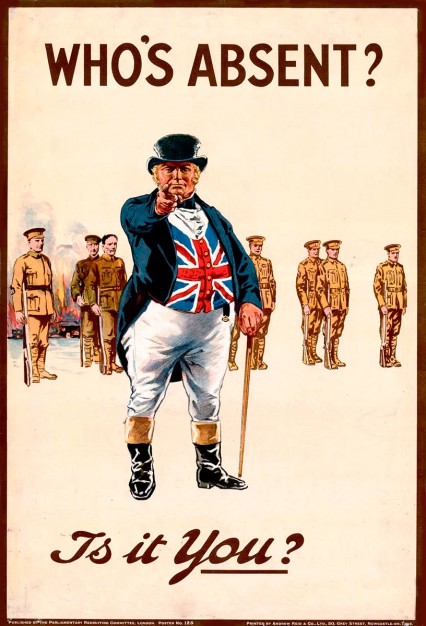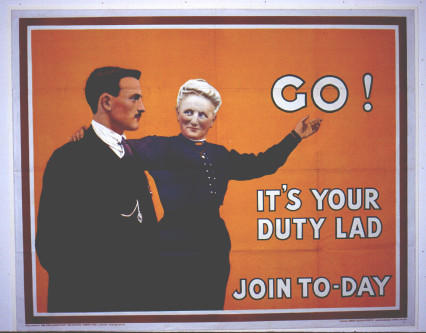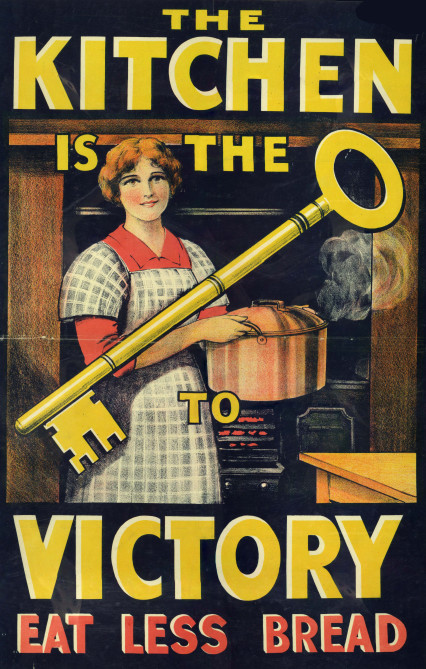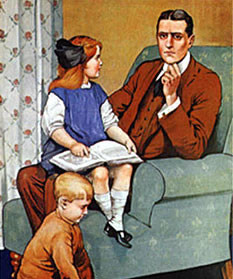Karen Westendorf reviews British WWI propaganda showcased in Ceredigion Museum, Aberystwyth as a part of the war commemorations.
A stern-looking John Bull points an accusing finger at me, asking in capital letters: ‘Who’s absent? Is it you?’ The ‘you’ is underlined for emphasis and I start feeling quite guilty. But, stop, this isn’t meant for me! First of all, this is a century-old poster; secondly, I’m a woman; and, oh yes, thirdly, I’m German, too. ‘Phew,’ I think relieved and wipe the cold sweat of my forehead; ‘I don’t need to join the army just yet.’
 Welcome to the world of propaganda, or to be more precise, British WWI propaganda, the first mass propaganda campaign of its kind. As part of the war commemorations, Ceredigion Museum in Aberystwyth is hosting an exhibition of original First World War propaganda posters until the 1st of May. First impressions are ‘colourful’ and ‘blunt’ – the British government certainly had no time for subtleties. The messages it wanted to convey are quite obvious: We need you! We need your money! We need you to make sacrifices for the greater good! We want to make the enemy look really bad. The posters are grouped around these four themes. The exhibited images have no labels, because, as Andrea DeRome, Collections Access Officer at Ceredigion Museum and curator of this show, explains, she wanted the posters to ‘speak for themselves.’ On a more practical level, they would have taken extra space which is already used to the maximum in the gallery. DeRome wanted to avoid taking out any of the framed originals that were first shown in Carmarthenshire and Swansea in 2015. The omission of the labels also generates more of a billboard effect which works especially well considering the topic. However, laminated information sheets can be picked up from the table next to the gallery entrance. They give limited details, such as date and artist, about each image.
Welcome to the world of propaganda, or to be more precise, British WWI propaganda, the first mass propaganda campaign of its kind. As part of the war commemorations, Ceredigion Museum in Aberystwyth is hosting an exhibition of original First World War propaganda posters until the 1st of May. First impressions are ‘colourful’ and ‘blunt’ – the British government certainly had no time for subtleties. The messages it wanted to convey are quite obvious: We need you! We need your money! We need you to make sacrifices for the greater good! We want to make the enemy look really bad. The posters are grouped around these four themes. The exhibited images have no labels, because, as Andrea DeRome, Collections Access Officer at Ceredigion Museum and curator of this show, explains, she wanted the posters to ‘speak for themselves.’ On a more practical level, they would have taken extra space which is already used to the maximum in the gallery. DeRome wanted to avoid taking out any of the framed originals that were first shown in Carmarthenshire and Swansea in 2015. The omission of the labels also generates more of a billboard effect which works especially well considering the topic. However, laminated information sheets can be picked up from the table next to the gallery entrance. They give limited details, such as date and artist, about each image.
In order to achieve their goal, the different propaganda agencies, committees and governmental departments played with the emotions of the public, regardless of the bloody consequences. In particular the ideas of morale, duty and guilt were exploited. The middle-aged mother, for example, takes her son by the shoulder and appeals to him: ‘Go! It’s your duty lad! Join to-day!’ This scene is set against a bright orange background which would have made it hard to overlook by any ‘lad’ who would have passed it. The son looks ever so slightly bored, with his hands in his pockets, but the mother’s facial expression leaves no doubt about what would happen if he didn’t enlist. He’d be seen as an honourless, lazy coward who didn’t want to defend his mother, his king and country against the bestial ‘Huns’. Another image sees the family dad years after the war with his daughter on his knee asking him what he did during the war. His worried eyes reveal to the observer that he was one of those who refused signing up and that admitting to it would make him a lesser man in the eyes of his children. Both images, just like the John Bull one, were created in 1915 when the first wave of enthusiasm for the war had died down and it was harder to find able men to join the army. A year later, conscription was introduced.
 The government not only required manpower but also financial support. From its very beginning in 1914, the conflict had cost about a million pounds per day, and by 1915 the need for extra cash was urgent. As one of the measures, the Parliamentary War Savings Committee decided to sell war bonds to the public. With a huge poster campaign, they promised not only that investing in the war would bring victory, but also that these bonds could provide a solid income either for old age or for the children: ‘War bonds feed the guns!’ declares one poster depicting red canons against a yellow sky whilst another adapts Whistler’s famous portrait of his mother to announce that ‘Old age must come’ and urges the viewer to ‘prepare for it by investing in war saving certificates.’ Putting the war certificates aside, the latter evokes a strange feeling of topicality. These days, pension schemes are again under discussion, and the public is advised to make their own arrangements and not rely on state pension.
The government not only required manpower but also financial support. From its very beginning in 1914, the conflict had cost about a million pounds per day, and by 1915 the need for extra cash was urgent. As one of the measures, the Parliamentary War Savings Committee decided to sell war bonds to the public. With a huge poster campaign, they promised not only that investing in the war would bring victory, but also that these bonds could provide a solid income either for old age or for the children: ‘War bonds feed the guns!’ declares one poster depicting red canons against a yellow sky whilst another adapts Whistler’s famous portrait of his mother to announce that ‘Old age must come’ and urges the viewer to ‘prepare for it by investing in war saving certificates.’ Putting the war certificates aside, the latter evokes a strange feeling of topicality. These days, pension schemes are again under discussion, and the public is advised to make their own arrangements and not rely on state pension.
By 1916 food was becoming scarce as well. The wheat harvest was lower than usual that year, and in January 1917 Germany declared unrestricted warfare, and their submarines attacked, among others, British merchant ships which imported necessary food supplies into the British kingdom. The new Ministry of Food started a campaign encouraging the public to ration their victuals with catchy phrases such as ‘Save the Wheat and Help the Fleet’ or ‘The Kitchen is the Key to Victory – Eat less Bread.’ Particularly the key was used as a symbol to emphasise the importance of their contribution at home. However, despite all efforts, rationing for foodstuffs such as sugar, meat, milk and flour, became mandatory by 1918 and everybody, including the royal family, were given ration books.
Given my nationality, I was especially intrigued by the posters that denounced the Germans as the barbarous enemy, who would not stop at slaughtering innocent mothers and children, and who were responsible for the invasion of Belgium and the sinking of the luxury ocean liner Lusitania in May 1915 during which 1,191 passengers and crew members lost their lives. There is even a poster with a slogan that seems to suggest an evil supernatural element to the enemy: ‘You have in your Pocket Silver Bullets that will stop the Germans’.
 The panels that accompany each section of the exhibition give some background information which satisfied, to an extent, the historical element of the exhibtion. However, it would have been interesting to see more discussion about the posters as works of art and the involved artists and illustrators such as Frank Brangwyn (1867-1956), J. Walter West (1860-1933), John Hassall (1868-1948), Arthur Wardle (1860-1949), Louis Raemaekers (1869-1956) and cartoonist Bert Thomas (1883-1966). It could also be argued that images of 21st century propaganda should have been shown as well, but again, this omission is down to lack of space as DeRome points out. Nevertheless, to give a hint about modern-day propaganda, she includes a small plinth plastered with contemporary advertisement in the middle of the room. This invites comparisons between political and other campaigns, now and then.
The panels that accompany each section of the exhibition give some background information which satisfied, to an extent, the historical element of the exhibtion. However, it would have been interesting to see more discussion about the posters as works of art and the involved artists and illustrators such as Frank Brangwyn (1867-1956), J. Walter West (1860-1933), John Hassall (1868-1948), Arthur Wardle (1860-1949), Louis Raemaekers (1869-1956) and cartoonist Bert Thomas (1883-1966). It could also be argued that images of 21st century propaganda should have been shown as well, but again, this omission is down to lack of space as DeRome points out. Nevertheless, to give a hint about modern-day propaganda, she includes a small plinth plastered with contemporary advertisement in the middle of the room. This invites comparisons between political and other campaigns, now and then.
Next to the plinth is also an ‘activity hub’ that encourages children to explore the exhibition. Speaking to the curator of Ceredigion Museum, Carrie Canham, she remarked that children, even quite young ones, ‘really got it.’ As an example, she tells me about a photo session during which children could dress up and pose in costumes inspired by the images. She talked to them about the depicted characters and asked them how they thought these people would feel; ‘nervous; scared; worried’ were the emotions they came up with. Canham adds that ‘it’s important not to glamourize or sanitize the war in any way,’ but that at the same time she ensures that she ‘wouldn’t show them anything graphic’ and that the parents were included in the discussion as well.
All in all, the exhibition is very well presented and visually engaging; it is historically interesting and certainly thought-provoking. Although it is fairly small, I have been back a few times after my first visit and discovered something new every time. There is also a series of events accompanying the show for adults, children and young people alike until the end of April. Details can be found on their website and programmes available at the museum.
Posters of the First World War: The Passion, the Propaganda and Print is on until Sunday, 01st May 2016 at the Ceredigion Museum in Aberystwyth.












